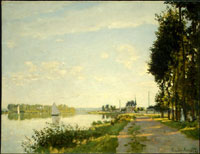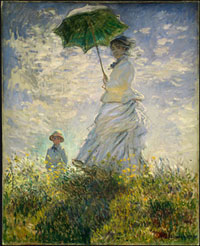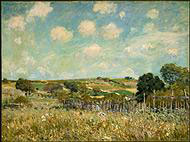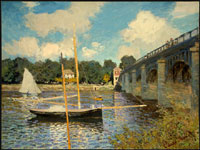

Looking at the rural landscape of Illinois, I am struck by its similarity to the imagined landscape of the 19th century Impressionist painters. I was reminded of this recently by an exhibition at the National Gallery in Washington, D.C.: "The Impressionists at Argenteuil."
In the 1870s a remarkable group of painters, Caillebotte, Manet, Monet, Renoir, Sisley and Boudin, gathered at the French village of Argenteuil. About 12 kilometers north of Paris, and therefore easily reached in under a half hour by train, the village spread along the banks of the Seine. It was apparently a rapidly growing region, with a large iron works and a recently built railroad. I say "apparently" because the paintings, at least to my eye, are quite odd in one respect: the world depicted is almost completely depopulated.
It was a willful aesthetic act. The petit bourgeois of the cities had long admired the estates outside of Paris. Moreover, the siege of Paris and the loss of the Franco-Prussian War of 1871 led to a longing for a simple life untroubled by war and urban decay. The countryside, unfortunately, was backward, filled with peasants, rude buildings, and the hum drum of everyday rural life. The Impressions created a virtual countryside, one in which their paintings depicted them ambling with friends and family, enjoying picnics and gazing at the quickly glimpsed play of light and shadow. Their success in depicting this countryside, in which they were masters of their environment with a brush stroke, charmed the city-bound middle class. It also set into the urban aesthete an idea of the countryside: smoothed, unthreatening, and relaxing. An "impression" of its bucolic pleasures.
continued
In the 1870s a remarkable group of painters, Caillebotte, Manet, Monet, Renoir, Sisley and Boudin, gathered at the French village of Argenteuil. About 12 kilometers north of Paris, and therefore easily reached in under a half hour by train, the village spread along the banks of the Seine. It was apparently a rapidly growing region, with a large iron works and a recently built railroad. I say "apparently" because the paintings, at least to my eye, are quite odd in one respect: the world depicted is almost completely depopulated.
It was a willful aesthetic act. The petit bourgeois of the cities had long admired the estates outside of Paris. Moreover, the siege of Paris and the loss of the Franco-Prussian War of 1871 led to a longing for a simple life untroubled by war and urban decay. The countryside, unfortunately, was backward, filled with peasants, rude buildings, and the hum drum of everyday rural life. The Impressions created a virtual countryside, one in which their paintings depicted them ambling with friends and family, enjoying picnics and gazing at the quickly glimpsed play of light and shadow. Their success in depicting this countryside, in which they were masters of their environment with a brush stroke, charmed the city-bound middle class. It also set into the urban aesthete an idea of the countryside: smoothed, unthreatening, and relaxing. An "impression" of its bucolic pleasures.
continued



| PAGE |<< | 1 | 2 | 3 | 4 | 5 | 6 | 7 | 8 | 9 | | ||
| D. Gorton's Home Page Jane Adams' Home Page Memory and Judgment: Mississippi The White South Contact Us |
|||||||||
|
This page was last modified on:
|
|||||||||